
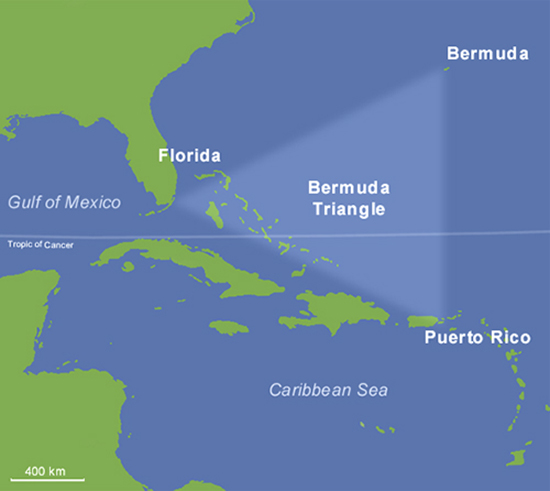


The Bermuda Triangle, situated between Florida, Bermuda and Puerto Rico has long been known as a region where many ships and planes have vanished. One of the eeriest disappearances was of Flight 19, a training mission involving five torpedo bombers. The planes left Fort Lauderdale on Dec. 5, 1945, on routine training and never came back. To make it creepier, the search plane dispatched also vanished.
�The Bermuda Triangle, also known as the Devil's Triangle, is a region of the northwestern Atlantic Ocean in which a number of aircraft and surface vessels have disappeared. Some people have claimed that these disappearances fall beyond the boundaries of human error or acts of nature. Some of these disappearances have been attributed to the paranormal, a suspension of the laws of physics, or activity by extraterrestrial beings by popular culture. Though a substantial documentation exists showing numerous incidents to have been inaccurately reported or embellished by later authors, and numerous official agencies have gone on record as stating the number and nature of disappearances to be similar to any other area of ocean, many have remained unexplained despite considerable investigation.
Major planetary grid points pass through the Bermuda Triangle and the Devil's Triangle (See below).
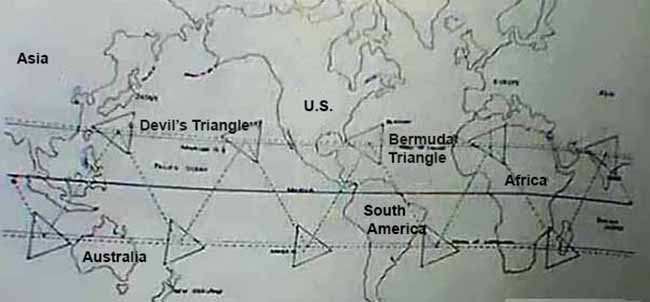
Bermuda Triangle: 25.0000° N, 71.0000° W
Devils (Dragon's) Triangle: 25.0010° N, 136.9987° E
The 1492 light sighting was witnessed by some crew members of Santa Maria, Pinta and possibly Nina shortly before the landing on Guanahani. The light was reported in Columbus' journal, Ferdinand Columbus' Vita del Ammiraglio (The Life of the Admiral), the proceedings of the Pleitos Colombinos (the long lawsuit involving the heirs of Columbus) and some other sources. Columbus described the light as "a small wax candle that rose and lifted up, which to few seemed to be an indication of land". He received the royal reward for the sighting. His son Ferdinand also characterized it as a candle, that went up and down. Read more ...
Columbus wrote: There exists the possibility of never leaving this legendary sea. My compass acts strangely. This sea seems to have the ability to draw things in from all over the Atlantic like a catch-basin.
The boundaries of the Triangle vary with the author; some stating its shape is akin to a trapezoid covering the Straits of Florida, the Bahamas, and the entire Caribbean island area east to the Azores; others add to it the Gulf of Mexico. The more familiar, triangular boundary in most written works has as its points somewhere on the Atlantic coast of Florida; San Juan, Puerto Rico; and the mid-Atlantic island of Bermuda, with most of the accidents concentrated along the southern boundary around the Bahamas and the Florida Straits.
The area is one of the most heavily-sailed shipping lanes in the world, with ships crossing through it daily for ports in the Americas, Europe, and the Caribbean Islands. Cruise ships are also plentiful, and pleasure craft regularly go back and forth between Florida and the islands. It is also a heavily flown route for commercial and private aircraft heading towards Florida, the Caribbean, and South America from points north.
The Gulf Stream ocean current flows through the Triangle after leaving the Gulf of Mexico; its current of five to six knots may have played a part in a number of disappearances. Sudden storms can and do appear, and in the summer to late fall hurricanes strike the area. The combination of heavy maritime traffic and tempestuous weather makes it inevitable that vessels could founder in storms and be lost without a trace - especially before improved telecommunications, radar, and satellite technology arrived late in the 20th century.
An explanation for some of the disappearances focuses on the presence of vast fields of methane hydrates on the continental shelves. A paper was published by the United States Geological Survey about the appearance of hydrates in the Blake Ridge area, offshore southeastern United States, in 1981. Periodic methane eruptions are capable of producing ship-sized bubbles, or regions of water with so much dissolved gas, that the fluid density is no longer capable of providing adequate buoyancy for ships to float. If this were the case, such an area forming around a ship could cause it to sink almost directly and without warning. Experiments have proven that a methane bubble can indeed sink a ship by decreasing the density of the water.
Methane gas can also crash planes. The less dense air causes planes to lose lift. Also, the altimeter of planes (the instrument that measures the altitude) functions on the density of air. Because methane is less dense, the altimeter assumes the plane is climbing. Planes at night or in the clouds, where they can't see the ground, assume that they are climbing and dive, causing them to crash. Also, methane in the engine throws off the mix of fuel and air. Aircraft engines burn hydrocarbons (gasoline or jet fuel) with oxygen provided by the air. When the ambient oxygen levels drop, combustion can stop, and the engine stalls. All of these effects of methane gas have been shown experimentally.
Laboratory experiments carried out in Australia have proven that bubbles can, indeed, sink a scale model ship by decreasing the density of the water; any wreckage consequently rising to the surface would be rapidly dispersed by the Gulf Stream. It has been hypothesized that periodic methane eruptions (sometimes called "mud volcanoes") may produce regions of frothy water that are no longer capable of providing adequate buoyancy for ships. If this were the case, such an area forming around a ship could cause it to sink very rapidly and without warning.
A white paper was published in 1981 by the United States Geological Survey about the appearance of hydrates in the Blake Ridge area, off the southeastern United States coast. However, according to a USGS web page, no large releases of gas hydrates are believed to have occurred in the Bermuda Triangle for the past 15,000 years.
Hurricanes are extremely powerful storms which are spawned in the Atlantic near the equator, and have historically been responsible for thousands of lives lost and billions of dollars in damage. The sinking of Francisco de Bobadilla's Spanish fleet in 1502 was the first recorded instance of a destructive hurricane. In 1988, Hurricane Gilbert, one of the most powerful hurricanes in history, set back Jamaica's economy by three years. These storms have in the past caused a number of incidents related to the Triangle.
The Gulf Stream is an ocean current that originates in the Gulf of Mexico, and then through the Straits of Florida, into the North Atlantic. In essence, it is a river within an ocean, and like a river, it can and does carry floating objects. A small plane making a water landing or a boat having engine trouble will be carried away from its reported position by the current, as happened to the cabin cruiser Witchcraft on December 22, 1967, when it reported engine trouble near the Miami buoy marker one mile (1.6 km) from shore, but was not there when a Coast Guard cutter arrived.
Extremely large waves can appear seemingly at random, even in calm seas. One such rogue wave caused the Ocean Ranger, then the world's largest offshore platform, to capsize in 1982. There is, however, no particular reason to believe rogue waves are more common in the Bermuda region, and this explanation cannot account for the loss of airplanes.
Research has shown that freak waves up to 30 m (100 feet) tall, capable of sinking the largest ships within moments, can and do happen. Although these are very rare, in some areas ocean currents mean they happen more often than the norm. Such waves have now been hypothesized as a cause for many unexplained shipping losses over the years.
The book was a best seller, and many interested readers offered theories to explain the nature of the disappearances. The list includes natural storms, transportation by extraterrestrial technology, high-traffic volumes (and correspondingly high accident rates), a "temporal hole," the lost Atlantis empire from the bottom of the ocean, and other natural and supernatural causes.
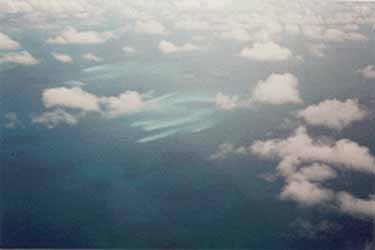
Aerial photos taken in 2005 show the phenomenon of glowing water. Whatever causes this phosphorescence to vent up from the Bahama Bank bottoms, if that is its cause, remains a mystery.
The Triangle's location in the Caribbean makes it subject to unpredictable weather patterns. This takes us to Earth changes and the excalation of intense hurricanes in 2005 with more to come in the years ahead.
These weather extremes prey on inexperienced navigators and smaller boats and planes. Water spouts, sudden electrical and thunder storms, and the like, can cause havoc in the area. The Gulf Stream can also be brutal in that region and perhaps has swept away evidence of natural disasters.
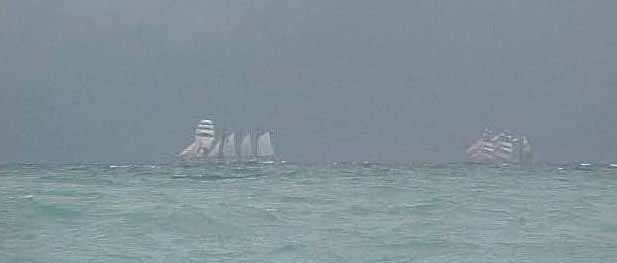
Many people have reported seeing portals opening in cloudy skies - strange swirling lights sometimes accompanied by sounds - temporal distortions - electromagnetic distortions called 'electronic fog' that can cause a time storm, and the disappearance of planes and ships. There is something about this fog that is important and gives one the sense of all things paranormal. Something unexplained is definitely happening in that region of the Atlantic. This goes back to ancient explorers such as Christopher Columbus and his crew who experienced the phenomenon.
The Comet Theory proposes that a comet, of unknown composition, crashed to Earth 11,000 + years ago and embedded itself in the area of the Bermuda Triangle, beneath the ocean floor. If such an object exists there, it could still possess electromagnetic properties that we don't entirely understand causing the anomalies in the Bermuda Triangle.
One of the most cited explanations in official inquiries as to the loss of any aircraft or vessel is human error. Whether deliberate or accidental, humans have been known to make mistakes resulting in catastrophe, and losses within the Bermuda Triangle are no exception. For example, the Coast Guard cited a lack of proper training for the cleaning of volatile benzene residue as a reason for the loss of the tanker V.A. Fogg in 1972. Human stubbornness may have caused businessman Harvey Conover to lose his sailing yacht, the Revonoc, as he sailed into the teeth of a storm south of Florida on January 1, 1958. It should be noted that many losses remain inconclusive due to the lack of wreckage which could be studied, a fact cited on many official reports.
This can fall into two categories: acts of war, and acts of piracy. Records in enemy files have been checked for numerous losses; while many sinkings have been attributed to surface raiders or submarines during the World Wars and documented in the various command log books, many others which have been suspected as falling in that category have not been proven; it is suspected that the loss of USS Cyclops in 1918, as well as her sister ships Proteus and Nereus in World War II, were attributed to submarines, but no such link has been found in the German records.
Piracy, as defined by the taking of a ship or small boat on the high seas, is an act which continues to this day. While piracy for cargo theft is more common in the western Pacific and Indian oceans, drug smugglers do steal pleasure boats for smuggling operations, and may have been involved in crew and yacht disappearances in the Caribbean. Historically famous pirates of the Caribbean (where piracy was common from about 1560 to the 1760s) include Edward Teach (Blackbeard) and Jean Lafitte. Lafitte is sometimes said to be a Triangle victim himself.
Another form of pirate operated on dry land. Bankers or wreckers would shine a light on shore to misdirect ships, which would then founder on the shore; the wreckers would then help themselves to the cargo. It is possible that these wreckers also killed any crew who protested. Nags Head, North Carolina, was named for the wreckers' practice of hanging a lantern on the head of a hobbled horse as it walked along the beach.
Triangle writers have used a number of supernatural theories to explain the events. One explanation pins the blame on leftover technology from the lost continent of Atlantis. Sometimes connected to the Atlantis story is the submerged rock formation known as the Bimini Road off the island of Bimini in the Bahamas, which is in the Triangle by some definitions. Followers of the purported psychic Edgar Cayce take his prediction that evidence of Atlantis would be found in 1968 or '69 as referring to the discovery of the Bimini Road. Believers describe the formation as a road, wall, or other structure, though geologists consider it to be of natural origin.
Other writers attribute the events to UFOs. This idea was used by Steven Spielberg for his film Close Encounters of the Third Kind, which features the lost Flight 19 as alien abductees. Charles Berlitz, grandson of a distinguished linguist and author of various additional books on anomalous phenomena, has kept in line with this extraordinary explanation, and attributed the losses in the Triangle to anomalous or unexplained forces.
The Atlantic Undersea Test and Evaluation Center is allegedly located in the Bermuda Triangle and is sometimes called Underwater Area 51. This US Navy Research Center is a top-secret facility whose exact mission statement is not known to the general public. No one is allowed to visit there or film in or near the facility. Conspiracy theorists suspect they make have created or reproduced these electromagnetic anomalies.
This theory takes the viewer to the events of the Philadelphia Experiment in 1943 - rips in space-time in the Atlantic region - government secret projects and more.
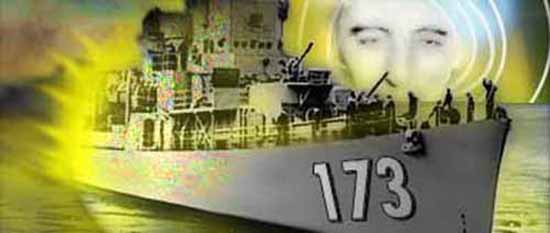
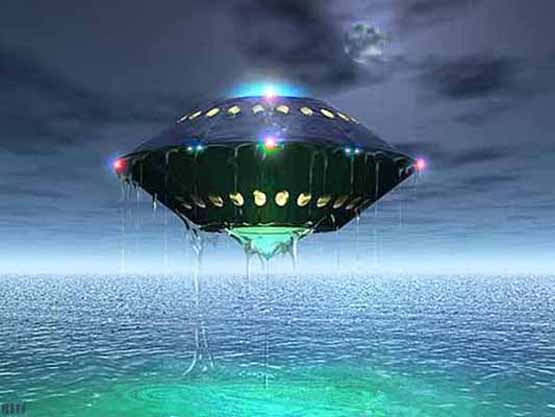
USO's - Unidentified Submerged Objects
Could extraterrestrials have anything to do with the Bermuda Triangle
perhaps as a vortex - indwells and out wells for spaceships?
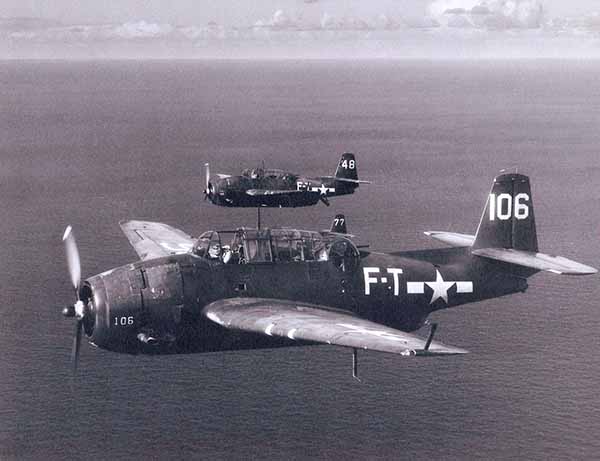
Flight 19 was a training flight of TBM Avenger bombers that went missing on December 5, 1945 while over the Atlantic. The impression is given that the flight encountered unusual phenomena and anomalous compass readings, and that the flight took place on a calm day under the supervision of an experienced pilot, Lt. Charles Carroll Taylor. Adding to the intrigue is that the Navy's report of the accident was ascribed to "causes or reasons unknown." It is believed that Taylor's mother wanted to save her son's reputation, so she made them write "reasons unknown" when actually Taylor was 50 km NW from where he thought he was.
While the basic facts of this version of the story are essentially accurate, some important details are missing. The weather was becoming stormy by the end of the incident; only Taylor had any significant flying time, but he was not familiar with the south Florida area and had a history of getting lost in flight, having done so three times during World War II, and being forced to ditch his planes twice into the water; and naval reports and written recordings of the conversations between Taylor and the other pilots of Flight 19 do not indicate magnetic problems.
On December 5th, 1945, five Avenger torpedo bombers lifted into the air from the Navel Air Station at Fort Lauderdale, Florida, at 2:10 in the afternoon. It was a routine practice mission and the flight was composed of all students except for the Commander, a Lt. Charles Taylor.
The mission called for Taylor and his group of 13 men to fly due east 56 miles to Hens and Chicken Shoals to conduct practice bombing runs. When they had completed that objective, the flight plan called for them to fly an additional 67 miles east, then turn north for 73 miles and finally straight back to base, a distance of 120 miles. This course would take them on a triangular path over the sea.
About an hour and a half after the flight had left, a Lt. Robert Cox picked up a radio transmission from Taylor. Taylor indicated that his compasses were not working, but he believed himself to be somewhere over the Florida Keys (the Keys are a long chain of islands south of the Florida mainland). Cox urged him to fly north, toward Miami, if Taylor was sure the flight was over the Keys.
Planes today have a number of ways that they can check their current position including listening to a set of GPS (Global Positioning Satellites) in orbit around the Earth. It is almost impossible for a pilot to get lost if he has the right equipment and uses it properly.
In 1945, though, planes flying over water had to depend on knowing their starting point, how long and fast they had flown, and in what direction. If a pilot made a mistake with any of these figures, he was lost. Over the ocean there were no landmarks to set him right.
Apparently Taylor had become confused at some point in the flight. He was an experienced pilot, but hadn't spent a lot of time flying east toward the Bahamas which was where he was going on that day. For some reason Taylor apparently thought the flight had started out in the wrong direction and had headed south toward the Florida Keys, instead of east. This thought was to color his decisions throughout the rest of the flight with deadly results.
The more Taylor took his flight north to try to get out of the Keys, the further out to sea the Avengers actually traveled. As time went on, snatches of transmissions were picked up on the mainland indicating the other Flight 19 pilots were trying to get Taylor to change course. "If we would just fly west," one student told another, "we would get home." He was right.
By 4:45 P.M. it was obvious to the people on the ground that Taylor was hopelessly lost. He was urged to turn control of the flight over to one of his students, but apparently he didn't. As it grew dark, communications deteriorated. From the few words that did get through it was apparent Taylor was still flying north and east, the wrong directions.
At 5:50 P.M. the ComGulf Sea Frontier Evaluation Center managed get a fix on Flight 19's weakening signals. It was apparently east of New Smyrna Beach, Florida. By then communications were so poor that this information could not be passed to the lost planes.
At 6:20 a Dumbo Flying Boat was dispatched to try and find Flight 19 and guide it back. Within the hour two more planes, Martin Mariners, joined the search. Hope was rapidly fading for Flight 19 by then. The weather was getting rough and the Avengers were very low on fuel.
The two Martin Mariners were supposed to rendezvous at the search zone. The second one, designated Training 49, never showed up.
The last transmission from Flight 19 was heard at 7:04 P.M. Planes searched the area through the night and the next day. There was no sign of the Avengers.
Nor did the authorities really expect to find much. The Avengers, crashing when their fuel was exhausted, would have been sent to the bottom in seconds by the 50 foot waves of the storm. As one of Taylor's colleagues noted, they didn't call those planes 'Iron Birds' for nothing. They weighed 14,000 pounds empty. So when they ditched, they went down pretty fast.
What happened to the missing Martin Mariner? The crew of the SS Gaines Mill observed an explosion over the water shortly after the Mariner had taken off. They headed toward the site and there they saw what looked like oil and airplane debris floating on the surface. None of it was recovered because of the bad weather, but there seems little doubt this was the remains of the Mariner. The plane had a reputation as being a 'flying bomb' which would burst into flame from even a single, small spark. Speculation is that one of 22 men on board, unaware that the unpressurized cabin contained gas fumes, lit a cigarette, causing the explosion.
So how did this tragedy turn into a Bermuda Triangle mystery? The Navy's original investigation concluded the accident had been caused by Taylor's confusion. Taylor's mother refused to accept that and finally got the Navy to change the report to read that the disaster was for "causes or reasons unknown." This may have spared the woman's feelings, but blurred the actual facts.
The saga of Flight 19 is probably the most repeated story about the Bermuda Triangle. The planes, and their pilots, even found their way into the science fiction film classic, 'Close Encounters of the Third Kind.'
Where is Flight 19 now? In 1991 five Avengers were found in 600 feet of water off the coast of Florida by the salvage ship Deep Sea. Examination of the planes showed that they were not Flight 19, however, so the final resting place of the planes, and their crews is still the Bermuda Triangle's secret.
The mysterious abandonment in 1872 of the Mary Celeste is often but inaccurately connected to the Triangle, the ship having been abandoned off the coast of Portugal. Many theories have been put forth over the years to explain the abandonment, including alcohol fumes from the cargo and insurance fraud. The event is possibly confused with the sinking of a ship with a similar name, the Mari Celeste, off the coast of Bermuda on September 13, 1864, which is mentioned in the book Bermuda Shipwrecks by Dan Berg.
The Ellen Austin supposedly came across an abandoned derelict, placed on board a prize crew, and attempted to sail with it to New York in 1881. According to the stories, the derelict disappeared; others elaborating further that the derelict reappeared minus the prize crew, then disappeared again with a second prize crew on board. A check of Lloyd's of London records proved the existence of the Meta, built in 1854; in 1880 the Meta was renamed Ellen Austin. There are no casualty listings for this vessel, or any vessel at that time, that would suggest a large number of missing men placed on board a derelict which later disappeared
The incident resulting in the single largest loss of life in the history of the U.S. Navy not related to combat occurred when USS Cyclops under the command of Lieutenant Commander G. W. Worley, went missing without a trace with a crew of 306 sometime after March 4, 1918, after departing the island of Barbados. Although there is no strong evidence for any theory, storms, capsizing and enemy activity have all been suggested as explanations.
Theodosia Burr Alston was the daughter of former United States Vice President Aaron Burr. Her disappearance has been cited at least once in relation to the Triangle, in The Bermuda Triangle by Adi-Kent Thomas Jeffrey (1975). She was a passenger on board the Patriot, which sailed from Charleston, South Carolina to New York City on December 30, 1812, and was never heard from again. Both piracy and the War of 1812 have been posited as explanations, as well as a theory placing her in Texas, well outside the Triangle.
Captain Joshua Slocum's skill as a mariner was beyond argument; he was the first man to sail around the world solo. In 1909, in his boat Spray he set out on a course to take him through the Caribbean to Venezuela. He disappeared; there was no evidence he was even in the Triangle when Spray was lost. It was assumed he was run down by a steamer or struck by a whale, the Spray being too sound a craft and Slocum too experienced a mariner for any other cause to be considered likely, and in 1924 he was declared legally dead. While a mystery, there is no known evidence for, or against, paranormal activity.
A five-masted schooner built in 1919, the Carroll A. Deering was found hard aground and abandoned at Diamond Shoals, near Cape Hatteras, North Carolina on January 31, 1921. Rumors and more at the time indicated the Deering was a victim of piracy, possibly connected with the illegal rum-running trade during Prohibition, and possibly involving another ship, S.S. Hewitt, which disappeared at roughly the same time. Just hours later, an unknown steamer sailed near the lightship along the track of the Deering, and ignored all signals from the lightship. It is speculated that the Hewitt may have been this mystery ship, and possibly involved in the Deering crew's disappearance.
On December 28, 1948, a Douglas DC-3aircraft, number NC16002, disappeared while on a flight from San Juan, Puerto Rico, to Miami. No trace of the aircraft or the 32 people onboard was ever found. From the documentation compiled by the Civil Aeronautics Board investigation, a possible key to the plane's disappearance was found, but barely touched upon by the Triangle writers: the plane's batteries were inspected and found to be low on charge, but ordered back into the plane without a recharge by the pilot while in San Juan. Whether or not this led to complete electrical failure will never be known. However, since piston-engined aircraft rely upon magnetos to provide electrical power and spark to their cylinders rather than batteries, this theory is unlikely.
These Avro Tudor IV passenger aircraft disappeared without trace en route to Bermuda and Jamaica, respectively. Star Tiger was lost on January 30, 1948 on a flight from the Azores to Bermuda. Star Ariel was lost on January 17, 1949, on a flight from Bermuda to Kingston, Jamaica. Neither aircraft gave out a distress call; in fact, their last messages were routine. A possible clue to their disappearance was found in the mountains of the Andes in 1998: the Star Dust, an Avro Lancastrian airliner run by the same airline, had disappeared on a flight from Buenos Aires, Argentina, to Santiago, Chile on August 2, 1947.
The plane's remains were discovered at the melt end of a glacier, suggesting that either the crew did not pay attention to their instruments, suffered an instrument failure or did not allow for headwind effects from the jetstream on the way to Santiago when it hit a mountain peak, with the resulting avalanche burying the remains and incorporating it into the glacier. However, this is mere speculation with regard to the Star Tiger and Star Ariel, pending the recovery of the aircraft. It should be noted that the Star Tiger was flying at a height of just 2,000 feet (610 m), which would have meant that if the plane was forced down, there would have been no time to send out a distress message. It is also far too low for the jetstream or any other high-altitude wind to have any effect.
On August 28, 1963 a pair of U.S. Air Force KC-135 Stratotanker aircraft collided and crashed into the Atlantic. The Triangle version (Winer, Berlitz, Gaddis) of this story specifies that they did collide and crash, but there were two distinct crash sites, separated by over 160 miles (260 km) of water. However, Kusche's research showed that the unclassified version of the Air Force investigation report stated that the debris field defining the second "crash site" was examined by a search and rescue ship, and found to be a mass of seaweed and driftwood tangled in an old buoy.
SS Marine Sulphur Queen, a T2 tanker converted from oil to sulfur carrier, was last heard from on February 4, 1963 with a crew of 39 near the Florida Keys. Marine Sulphur Queen was the first vessel mentioned in Vincent Gaddis' 1964 Argosy Magazine article, but he left it as having "sailed into the unknown", despite the Coast Guard report which not only documented the ship's badly-maintained history, but declared that it was an unseaworthy vessel that should never have gone to sea.
One of the more famous incidents in the Triangle took place in 1921 (some say a few years later), when the Japanese vessel Raifuku Maru (sometimes misidentified as Raikuke Maru) went down with all hands after sending a distress signal which allegedly said "Danger like dagger now. Come quick!", or "It's like a dagger, come quick!" This has led writers to speculate on what the "dagger" was, with a waterspout being the likely candidate (Winer). In reality the ship was nowhere near the Triangle, nor was the word "dagger" a part of the ship's distress call ("Now very danger. Come quick."); having left Boston for Hamburg, Germany, on April 21, 1925, she got caught in a severe storm and sank in the North Atlantic with all hands while another ship, RMS Homeric, attempted an unsuccessful rescue.
A pleasure yacht found adrift in the Atlantic south of Bermuda on September 26, 1955; it is usually stated in the stories (Berlitz, Winer) that the crew vanished while the yacht survived being at sea during three hurricanes. The 1955 Atlantic hurricane season lists only one storm coming near Bermuda towards the end of August, hurricane "Edith"; of the others, "Flora" was too far to the east, and "Katie" arrived after the yacht was recovered. It was confirmed that the Connemara IV was empty and in port when "Edith" may have caused the yacht to slip her moorings and drift out to sea.
The marine insurer Lloyd's of London has determined the Triangle to be no more dangerous than any other area of ocean, and does not charge unusual rates for passage through the region. United States Coast Guard records confirm their conclusion. In fact, the number of supposed disappearances is relatively insignificant considering the number of ships and aircraft which pass through on a regular basis.
The Coast Guard is also officially skeptical of the Triangle, noting that they collect and publish, through their inquiries, much documentation contradicting many of the incidents written about by the Triangle authors. In one such incident involving the 1972 explosion and sinking of the tanker V.A. Fogg in the Gulf of Mexico, the Coast Guard photographed the wreck and recovered several bodies despite one Triangle author stating that all the bodies had vanished, with the exception of the captain, who was found sitting in his cabin at his desk, clutching a coffee cup (Limbo of the Lost by John Wallace Spencer, 1973 edition).
The NOVA / Horizon episode The Case of the Bermuda Triangle (June 27, 2006) was highly critical stating that "When we've gone back to the original sources or the people involved the mystery evaporates. Science does not have to answer questions about the Triangle because those questions are not valid in the first place. ... Ships and planes behave in the Triangle the same way they behave everywhere else in the world"
Skeptical researchers, such as Ernest Taves and Barry Singer, have noted how mysteries and the paranormal are very popular and profitable. This has led to the production of vast amounts of material on topics such as the Bermuda Triangle. They were able to show that some of the pro-paranormal material is often misleading or not accurate, but its producers continue to market it. They have therefore claimed that the market is biased in favor of books, TV specials, et cetera. which support the Triangle mystery and against well-researched material if it espouses a skeptical viewpoint.
Finally, if the Triangle is assumed to cross land, such as parts of Puerto Rico, the Bahamas, or Bermuda itself, there is no evidence for the disappearance of any land-based vehicles or persons. Located inside the Triangle, Freeport operates a major shipyard, an airport which yearly handles 50,000 flights and is visited by over a million tourists annually.
Compass problems are one of the cited phrases in many Triangle incidents. Some have theorized the possibility of unusual local magnetic anomalies in the area, however these have not been shown to exist. It should also be remembered that compasses have natural magnetic variations in relation to the Magnetic poles. For example, in the United States the only places where magnetic (compass) north and geographic (true) north are exactly the same are on a line running from Wisconsin to the Gulf of Mexico. Navigators have known this for centuries. But the public may not be as informed and think there is something mysterious about the compass "changing" across an area as large as the Triangle, which it naturally will.

Located on the 80th degree longitude, the Bermuda Triangle is one of the two areas on Earth where a compass will point at true north rather than magnetic north. This compass variation can be as much as 20 degrees, enough to throw one catastrophically off course. The other is the Devil's Sea.
List of Bermuda Triangle Incidents
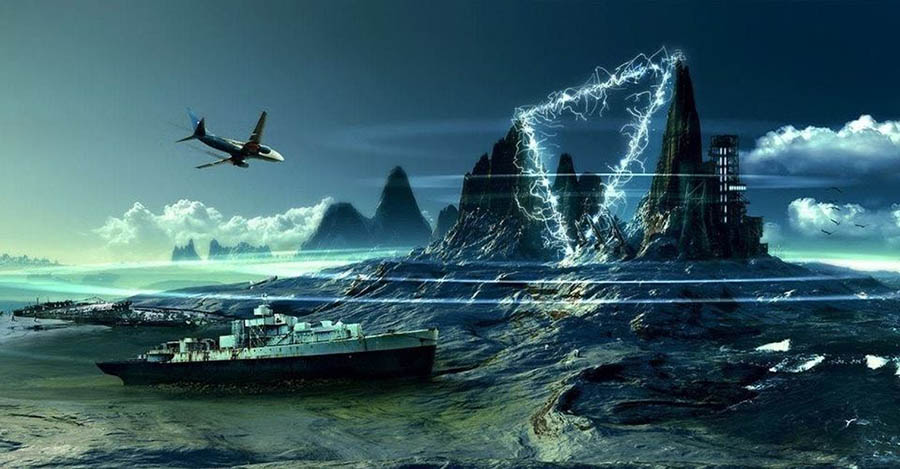
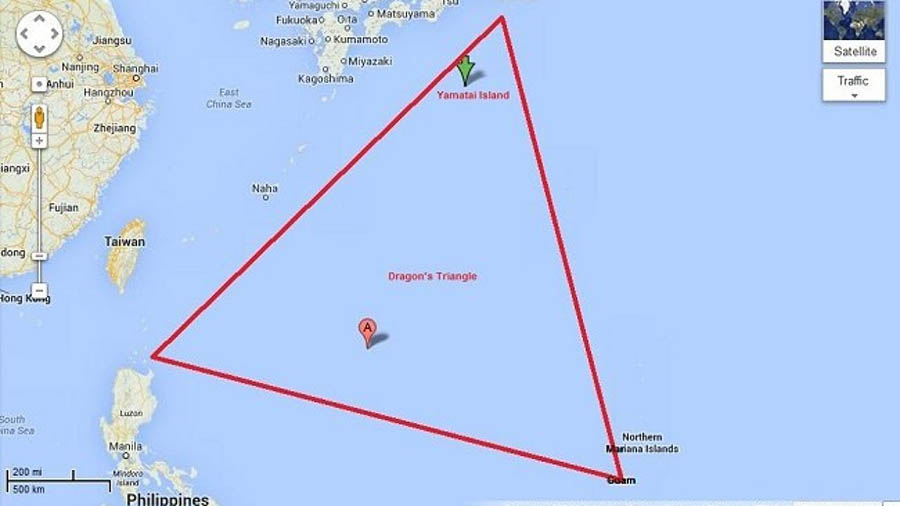
The Devil's Sea is classified by many as having the same paranormal effects as the Bermuda Triangle. It is located in a region of the Pacific around Miyake Island, about 100 km south of Tokyo. Although the name is used by Japanese fishermen, it does not appear on nautical maps. In popular culture, especially in the United States, the Devil's Sea is widely believed to be, together with Bermuda Triangle, an area where ships and planes particularly often disappear mysteriously. The Japanese, on the other hand, do not consider the Devil's Sea to be any more mysterious or dangerous than other coastal waters of Japan.
Contrary to several claims, neither the Devil's Sea nor the Bermuda Triangle is located on the agonic line, where the magnetic north equals the geographic north. The magnetic declination in this area is about 6 degrees. As is the case with all things mysterious, there are many theories regarding the Devil's Sea. One of the most prominent is that there is a large amount of volcanic activity around the area, and an underwater volcano could obliterate a ship without a trace.
The Lake Michigan Triangle - sometimes referred to as the Michigan Triangle - spans from Manitowoc, Wisconsin, to Ludington, Michigan, and south to Benton Harbor. The triangle has accounted for numerous mysterious events, beginning in 1891, when a schooner named the Thomas Hume set off across Lake Michigan for lumber.
There are numerous stories of the alleged appearance of strange creatures, unexplained vanishings, time standing still, slowing to a crawl, or speeding up, or other weird happenings.
One well-documented and well-known case includes that of Captain George R. Donner, who commanded the Great Lakes freighter O.M. McFarland. While on a journey back from Erie, Pennsylvania after picking up 9,800 tons of coal, the ship made course westward through the lakes. It was slow going due to late-spring ice floes, but the ship was making steady progress toward its destination, Port Washington, Wisconsin, when Donner disappeared.
On the night of April 28, 1937, the captain took to his cabin, with instructions to be awakened as the ship drew near to port. About three hours later, with Port Washington growing close, the second mate appeared at the captain's cabin, prepared to awake him, but found no one. He and the crew searched the ship, but the captain was nowhere to be seen. The mate reported that the cabin door was locked from the inside, adding to the mystery of the triangle. Reportedly, the ship was in the dead center of the triangle when the captain disappeared.
Another disappearance took place on June 23, 1950, and involved a Northwest Airlines DC-4 aircraft carrying fifty-five passengers and three crew members. This flight 2501 had departed from New York City and was due to land at Minneapolis. The last radio contact recorded with the plane was that it was 3,500 feet over Battle Creek, Michigan and was going to change its course to a northwesterly path over Lake Michigan, due to bad weather near Chicago. After this, the plane was never seen again, nor were the occupants. Even after an extensive search by the Coast Guard, only a blanket with the airline's logo was found. Once again, the aircraft was in the center of the supposed triangle when it disappeared.
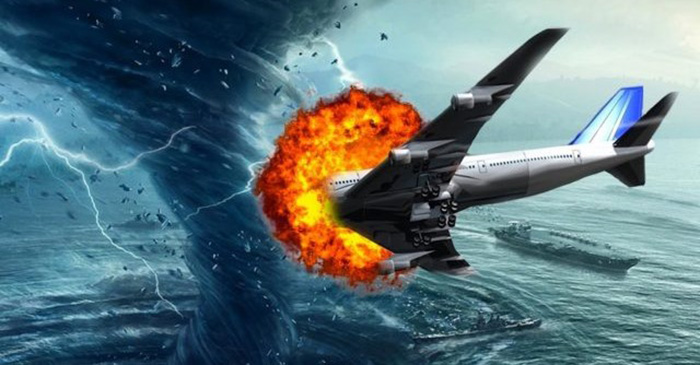
The Los Roques archipelago of Venezuela is a collection of around 350 islands, cays, and islets lying out in the Caribbean Sea about 80 miles north of the port of La Guaira. By all appearances this is an enchanting land of inviting green islands, uninhabited atolls, and beautiful azure waters, and is famous for the extensive coral reefs of the area that draw in visitors from all over the world. Such is the biodiversity of this region, that Los Roques is designated as a national park and protected area, and it has become the destination for the rich and famous, who ride their fancy yachts in to enjoy some of the most breathtaking island scenery on earth. Yet, for all of this charm and beauty there seem to be dark forces pulsing under the surface, and the islands have gained a reputation for drawing people in to never return.
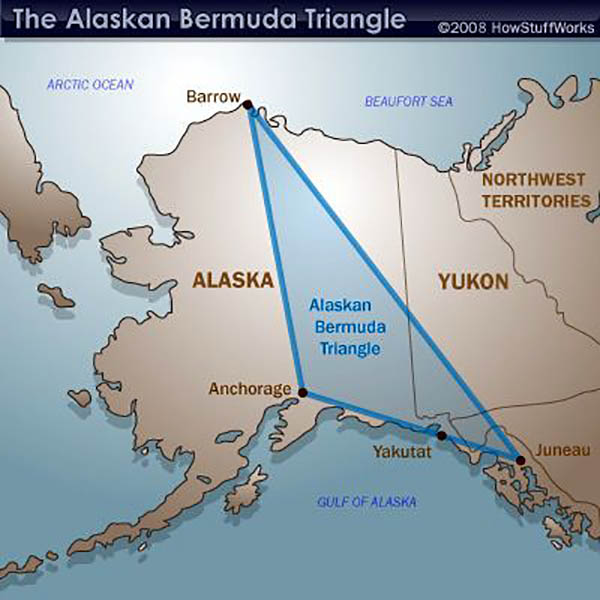
Alaskan Anomalies

Vanished